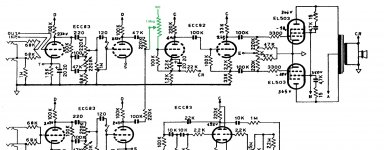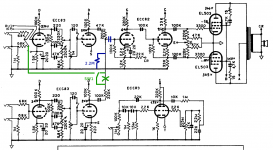Hello,
I'm tweaking with an old FBT500 tube amp (schematic here http://el34world.com/charts/Schematics/files/FBT/FBT 500 R.pdf )
This amplifier has two inputs with independent preamps, each using a ECC83 tube implementing a two stage amplifier with tone stack and volume control.
I would like to cascade the two preamps in order to obtain a distorted channel withouth pushing the amp to the limits (it's a 50W amp... you need a very big room to push it into distortion without blowing your ears!).
Do you think it's a good idea? Is there something I should be careful about?
Thanks
I'm tweaking with an old FBT500 tube amp (schematic here http://el34world.com/charts/Schematics/files/FBT/FBT 500 R.pdf )
This amplifier has two inputs with independent preamps, each using a ECC83 tube implementing a two stage amplifier with tone stack and volume control.
I would like to cascade the two preamps in order to obtain a distorted channel withouth pushing the amp to the limits (it's a 50W amp... you need a very big room to push it into distortion without blowing your ears!).
Do you think it's a good idea? Is there something I should be careful about?
Thanks
OK I'm not expert but based on a similar problem I had with my Fender Hotrod (way too loud) I had an effects loop so i did a simple variable resistor box that I plug in there when i want to run my preamp hot but still control output amp separate.
Examining your schematic I think the mod in green will work ok. I would use a 1 meg variable, audio taper if you have it.
jpeg attached
Examining your schematic I think the mod in green will work ok. I would use a 1 meg variable, audio taper if you have it.
jpeg attached
Attachments
> Do you think it's a good idea?
No.
That will be WAY too much gain.
There's no way to turn-down the HUGE signal before it hits the output bottles.
There's a shared bias resistor which can't be shared if the two channels are cascaded.
Put a boost/distortion in front, and probably a power-soak on the output or a master volume inside.
No.
That will be WAY too much gain.
There's no way to turn-down the HUGE signal before it hits the output bottles.
There's a shared bias resistor which can't be shared if the two channels are cascaded.
Put a boost/distortion in front, and probably a power-soak on the output or a master volume inside.
Thank you for the comments.
I was thinking about something like the attached schematic. Green is the modified signal path, blue is some added component to manage DC (otherwise I think there would be a big pop when switching SW1)
The switch allows to use the amp in the original mode or in single channel distorted mode.
In distorted mode, the volume dial of the lower channel (the first in the chain) controls distortion, while the other one controls volume.
I've tried it quickly and it works... but I don't know if there's any risk in this circuit (I'm not a tube expert and I don't know what can damage a tube), or if there is a smater way to do something like this.
I can push all the way up the first dial as long as the second one is kept around 10% for playing in a garage.
I was thinking about something like the attached schematic. Green is the modified signal path, blue is some added component to manage DC (otherwise I think there would be a big pop when switching SW1)
The switch allows to use the amp in the original mode or in single channel distorted mode.
In distorted mode, the volume dial of the lower channel (the first in the chain) controls distortion, while the other one controls volume.
I've tried it quickly and it works... but I don't know if there's any risk in this circuit (I'm not a tube expert and I don't know what can damage a tube), or if there is a smater way to do something like this.
I can push all the way up the first dial as long as the second one is kept around 10% for playing in a garage.
Attachments
Increase the lower 2nd triode's cathode resistor to about 1k5, add another 1k5/20µ combo to the upper 2nd triode's cathode and another 2M2 resistor to the 100n capacitor after the lower 2nd triode. Where's the »T« output of the tremolo circuit connected to? And - you don't really operate EL503's?
Best regards!
Best regards!
Thank you Kay,
the purpose of the mod you suggest is to keep the two channels more separated and avoid unwanted loops, right?
The second 2.2M shouldn't be required, that node is always biased to 0V, either by the second preamp input, or by the 2.2M on the other side.
Regarding the output tetrodes, yes, they are EL503. I hope not to damage them. If I do, I'll experiment with some different tubes (6p45s are an interesting option, i think).
I already had to change the fixed bias to a cathode bias, the tubes I could find were not matched and required a very different bias (-20V on one, -26 on the other), far beyond the capabilities of the bias circuit.
the purpose of the mod you suggest is to keep the two channels more separated and avoid unwanted loops, right?
The second 2.2M shouldn't be required, that node is always biased to 0V, either by the second preamp input, or by the 2.2M on the other side.
Regarding the output tetrodes, yes, they are EL503. I hope not to damage them. If I do, I'll experiment with some different tubes (6p45s are an interesting option, i think).
I already had to change the fixed bias to a cathode bias, the tubes I could find were not matched and required a very different bias (-20V on one, -26 on the other), far beyond the capabilities of the bias circuit.
Where's the »T« output of the tremolo circuit connected to?
It's connected to the upper left triode cathode (the 'T' is just below the green line).
A simpler and more versatile solution is to mod just one of the channels, so that the tone stack comesafter the second gain preamp stage. Basically, just follow the 2-stage preamp design of the P1 eXtreme on AX84.com, or from the 18W Suprtlite on 18W.com, a well proven preamp design. That will give you one Marshall-flavoured distortion channel, and one Fender-like clean channel!
Sent from my phone. Please excuse any typpos.
Sent from my phone. Please excuse any typpos.
What is the purpose of moving the tone stack one step after in the signal chain? Is it to suppress the high order harmonics coming from the distortion, or something else?
- Status
- Not open for further replies.
- Home
- Live Sound
- Instruments and Amps
- Adding distorted channel to a FBT500 tube amp

